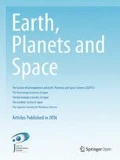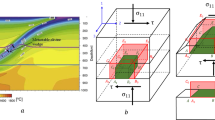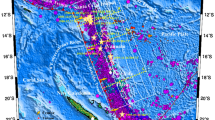Abstract
Latent heat release by equilibrium mineralogical transformations in an adiabatically subducting slab reversibly perturbs temperatures and pressures so as to conserve entropy. However, latent heats of metastable transformations in such a slab yield irreversible isobaric temperature changes which increase entropy despite adiabatic constraints. As a result, latent heat release by metastable exothermic transformations can yield local superheating above the background adiabat, with the degree of potential superheating increasing with extent of metastable overstep. In real slabs, however, regions of metastably persisting low-pressure phases should undergo conductive warming from surrounding transformed material. Such warming should proceed more rapidly than warming of the bulk slab from the surrounding mantle, and the resulting decrease in metastable transition pressures will slightly decrease the degree of local superheating. Nonetheless, such local temperature increases may trigger seismic release of accumulated strain energy via a number of proposed mechanisms of shear instability. Adiabatic instability, in the form of shear localization in material with temperature-dependent rheology, is one mechanism which may be triggered by such latent heat release in metastable regions yet produce rupture that extends beyond the boundaries of such regions.
Similar content being viewed by others
References
Akaogi, M., H. Kojitani, K. Matsuzaka, and T. Suzuki, Postspinel transformations in the system Mg2SiO4-Fe2SiO4: Element partitioning, calo-rimetry, and thermodynamic calculation, in Properties of Earth and Planetary Materials at High Pressure and Temperature, edited by M. H. Manghnani and T. Yagi, pp. 373–384, American Geophysical Union, Washington, D.C., 1998.
Austrheim, H. and T. M. Boundy, Eclogite facies pseudotachylytes from the Bergen Arcs, western Norway: Records of rapid faulting and seismicity during eclogitization of the deep crust, Science, 265, 82–83, 1994.
Austrheim, H., M. Erambert, and T. M. Boundy, Garnets recording deep crustal earthquakes, Earth Planet. Sci. Lett., 139, 223–238, 1996.
Bina, C. R., Phase transition buoyancy contributions to stresses in subducting lithosphere, Geophys. Res. Lett., 23, 3563–3566, 1996.
Bina, C. R., Patterns of deep seismicity reflect buoyancy stresses due to phase transitions, Geophys. Res. Lett., 24, 3301–3304, 1997.
Brearley, A. J. and D. C. Rubie, Transformation mechanisms of San Carlos olivine to (Mg,Fe)2 SiO4 -phase under subduction zone conditions, Phys. Earth Planet. Inter., 86, 45–67, 1994.
Bridgman, P. W., Polymorphic transitions and geological phenomena, Am. J. Sci., 243a, 90–97, 1945.
Burnley, P. C., The fate of olivine in subducting slabs: A reconnaissance study, Amer. Mineral., 80, 1293–1301, 1995.
Chai, M., J. M. Brown, and Y. Wang, Yield strength, slip systems and deformation induced phase transition of San Carlos olivine up to transition zone pressure at room temperature, in Properties of Earth and Planetary Materials at High Pressure and Temperature, edited by M. H. Manghnani and T. Yagi, pp. 483–494, American Geophysical Union, Washington, D.C., 1998.
Daessler, R. and D. A. Yuen, The effects of phase transition kinetics on subducting slabs, Geophys. Res. Lett., 20, 2603–2606, 1993.
Daessler, R., D. A. Yuen, S. Karato, and M. R. Riedel, Two-dimensional thermo-kinetic model for the olivine-spinel phase transition in subducting slabs, Phys. Earth Planet. Inter., 94, 217–239, 1996.
Devaux, J. P., G. Schubert, and C. Anderson, Formation of a metastable olivine wedge in a descending slab, J. Geophys. Res., 102, 24,627–24,637, 1997.
Fei, Y., H.-K. Mao, and B. O. Mysen, Experimental determination of element partitioning and calculation of phase relations in the MgO-FeO-SiO2 system at high pressure and high temperature, J. Geophys. Res., 96, 2157–2169, 1991.
Goto, K., Z. Suzuki, and H. Hamaguchi, Stress distribution due to olivine-spinel phase transition in descending plate and deep focus earthquakes, J. Geophys. Res., 92, 13,811–13,820, 1987.
Green, H. W., II and H. Houston, The mechanics of deep earthquakes, Annu. Rev. Planet. Sci., 23, 169–213, 1995.
Green, H. W., II and Y. Zhou, Transformation-induced faulting requires an exothermic reaction and explains the cessation of earthquakes at the base of the mantle transition zone, Tectonophys., 256, 39–56, 1996.
Hobbs, B. E. and A. Ord, Plastic instabilities: Implications for the origin of intermediate and deep focus earthquakes, J. Geophys. Res., 93, 10,521–10,540, 1988.
Hogrefe, A., D. C. Rubie, T. G. Sharp, and F. Seifert, Metastability of enstatite in deep subducting lithosphere, Nature, 372, 351–353, 1994.
Jeanloz, R. and A. B. Thompson, Phase transitions and mantle discontinuities, Rev. Geophys. Space Phys., 21, 51–74, 1983.
Jin, J., S.-I. Karato, and M. Obata, Mechanisms of shear localization in the continental lithosphere: Inference from the deformation microstructures of peridotites from the Ivrea zone, northwestern Italy, J. Struct. Geol., 20, 195–209, 1998.
Kanamori, H., D. L. Anderson, and F. H. Heaton, Frictional melting during the rupture of the 1994 Bolivian earthquake, Science, 279, 839–842, 1998.
Karato, S.-I., Phase transformations and rheological properties of mantle minerals, in Earth’s Deep Interior: The Doornbos Memorial Volume, edited by D. J. Crossley, pp. 223–272, Gordon and Breach, Amsterdam, 1997.
Kerschhofer, L., T. G. Sharp, and D. C. Rubie, Intracrystalline transformation of olivine to wadsleyite and ringwoodite under subduction zone conditions, Science, 274, 79–81, 1996.
Kirby, S. H., W. B. Durham, and L. Stern, Mantle phase changes and deep-earthquake faulting in subducting slabs, Science, 252, 216–225, 1991.
Kirby, S. H., S. Stein, E. A. Okal, and D. C. Rubie, Metastable mantle phase transformations and deep earthquakes in subducting oceanic lithosphere, Rev. Geophys., 34, 261–306, 1996.
Klotz, I. M., Chemical Thermodynamics, 468 pp., W. A. Benjamin Inc., New York, 1964.
Kubo, T., E. Ohtani, T. Kato, H. Morishima, D. Yamazaki, A. Suzuki, K. Mibe, T. Kikegawa, and O. Shimomura, An in situ X ray diffraction study of the α-β transformation kinetics of Mg2 SiO4, Geophys. Res. Lett., 25, 695–698, 1998.
Myers, S. C., T. C. Wallace, S. L. Beck, P. G. Silver, G. Zandt, J. VanDecar, and E. Minaya, Implications of spatial and temporal development of the aftershock sequence for the Mw 8.3 June 9, 1994 deep Bolivia earthquake, Geophys. Res. Lett., 22, 2269–2272, 1995.
Obata, M. and S.-I. Karato, Ultramafic pseudotachylite from the Balmuccia peridotite, Ivrea-Verbano zone, northern Italy, Tectonophys., 242, 313–328, 1995.
Ogawa, M., Shear instability in a viscoelastic material as the cause of deep focus earthquakes, J. Geophys. Res., 92, 13,801–13,810, 1987.
Okal, E. A. and C. R. Bina, On the cessation of seismicity at the base of the transition zone, J. Seism., 2, 65–86, 1998.
Pinsky, M. A., Partial Differential Equations and Boundary-Value Problems with Applications, 461 pp., McGraw-Hill, New York, 1991.
Regenauer-Lieb, K. and D. A. Yuen, Rapid conversion of elastic energy into plastic shear heating during incipient necking of the lithosphere, Geophys. Res. Lett., 25, 2737–2740, 1998.
Rubie, D. C. and C. R. Ross, II, Kinetics of the olivine-spinel transformation in subducting lithosphere: Experimental constraints and implications for deep slab processes, Phys. Earth Planet. Inter., 86, 223–241, 1994.
Sharp, T. G. and D. C. Rubie, Catalysis of the olivine to spinel transformation by high-clinoenstatite, Science, 269, 1095–1098, 1995.
Silver, P. G., S. L. Beck, T. C. Wallace, C. Meade, S. C. Myers, D. E. James, and R. Kuehnel, Rupture characteristics of the deep Bolivian earthquake of 9 June 1994 and the mechanism of deep-focus earthquakes, Science, 268, 69–73, 1995.
Sung, C.-M. and R. G. Burns, Kinetics of the olivine-spinel transition: Implications to deep-focus earthquake genesis, Earth Planet. Sci. Lett., 32, 165–170, 1976a.
Sung, C.-M. and R. G. Burns, Kinetics of the high-pressure phase transformations: Implications to the evolution of the olivine-spinel phase transition in the downgoing lithosphere and its consequences on the dynamics of the mantle, Tectonophys., 31, 1–32, 1976b.
Vassiliou, M. S. and B. H. Hager, Subduction zone earthquakes and stress in slabs, Pure Appl. Geophys., 128, 547–624, 1988.
Wiens, D. A. and H. J. Gilbert, Effect of slab temperature on deep-earthquake aftershock productivity and magnitude-frequency relations, Nature, 384, 153–156, 1996.
Wiens, D. A., J. J. McGuire, and P. J. Shore, Evidence for transformational faulting from a deep double seismic zone in Tonga, Nature, 364, 790–793, 1993.
Wiens, D. A., J. J. McGuire, P. J. Shore, M. G. Bevis, K. Draunidalo, G. Prasad, and S. P. Helu, A deep earthquake aftershock sequence and implications for the rupture mechanism of deep earthquakes, Nature, 372, 540–543, 1994.
Woodland, A. B., The orthorhombic to high-P monoclinic phase transition in Mg-Fe pyroxenes: Can it produce a seismic discontinuity?, Geophys. Res. Lett., 25, 1241–1244, 1998.
Yoshioka, S., R. Daessler, and D. A. Yuen, Stress fields associated with metastable phase transitions in descending slabs and deep-focus earthquakes, Phys. Earth Planet. Inter., 104, 345–361, 1997.
Author information
Authors and Affiliations
Corresponding author
Rights and permissions
About this article
Cite this article
Bina, C.R. A note on latent heat release from disequilibrium phase transformations and deep seismogenesis. Earth Planet Sp 50, 1029–1034 (1998). https://doi.org/10.1186/BF03352197
Received:
Revised:
Accepted:
Published:
Issue Date:
DOI: https://doi.org/10.1186/BF03352197




